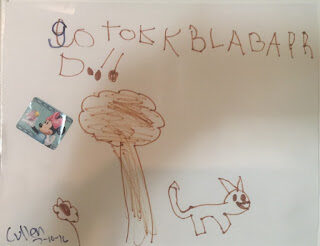Moving Reluctant Writers with Technology to Support their Thinking
Invented Spelling to tell story about “my weekend”
(translation: Go to Kk birthday party)
Moving students along a continuum towards “emergent writer” takes time, practice, modeling, and most importantly MOTIVATION.
Regardless of where students are at the beginning of the year, it is important for the teacher to make note of how a student advances with continuous progress monitoring. In the student sample above invented spelling provides evidence of knowledge of letter-sound relationships as well as writing development.
A first grade teacher might see a range of students from using pre-phonemic spelling which contains letters but do not represent sounds in a meaningful way, to invented spelling which contains use of the alphabetic principle such as letter(s) representing words.
Do you know the seven major forms of emergent writing.
1. Drawing: Illustration to represent the meaning of a story or event.
2. Scribbling: A line of writing similar to a series of waves.
3. Letter-like forms: manuscript that are written in separate forms but are not real letters.
4. Pre-phonemic Spelling: letters that are a meaningless pattern and do not represent sound.
5. Copying: spelling copied from the environment with no meaning to the story.
6. Invented Spelling: Letters represent sound.
7. Conventional spelling: Traditional spelling patterns and writing conventions.
(Sulzby, 1989).
Teachers need to be aware of the different stages to move students forward towards writing independently. But motivating students to write can be a difficult task as it is hard work and requires concentration. Students might be hesitant to take risks in writing words they can not spell or continue to use invented spelling rather than use words they have been taught.
Modeling is an important part of children’s early writing attempts, however with such a range of learners across the classroom this can be challenging for the teacher to meet everyone’s ability.
What if there was a way for modeling to be something that comes from the child and not necessarily the adult. Students will be motivated to write and read when they see THEIR stories on paper. The relationship between reading and writing is bidirectional, as writing improves so does students’ reading and vice versa.
Typing can be a tedious task one that requires memorization of the keyboard and concentration on creating grammatically correct sentences. For emergent writers the goal of putting ideas on paper and connecting with their ideas is a complex task but what student wouldn’t want to read a story they wrote?
This is where technology can once again be used to harness students’ ability to become independent readers and writers. Using Google Docs students can narrate their story to text using the Voice to Type feature (see video above of a first grade students showing this process). You just might see more students taking risks and extending their thinking with this feature. Once more this process shows students they can be writers and share their ideas with the world.
In an earlier post I shared how to use the Tool WriteReader to create student digital books. How are you using technology tools to support emergent readers and writers and most importantly motivating students to write?





